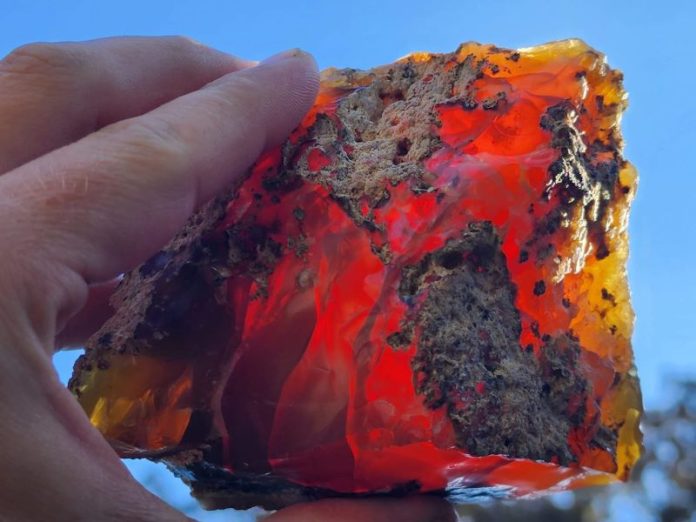
Fire opal in your hands is like holding a brilliant red, orange or yellow treasure of Prometheus, the Titan who gave fire to mankind and changed the world forever. These beautiful orange gems still hold the power to shape lives and dazzle those who discover their alluring qualities.
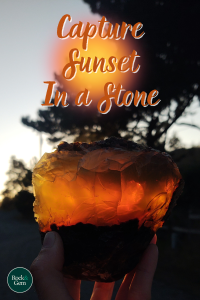
How is Fire Opal Formed?
Created in volcanic regions, opals, in general, require an almost alchemic scenario to form their beautiful forms and colorations. Made of hydrated silica, scientists believe when water passes through quartz-rich deposits, such as rhyolite, it creates a silica solution that finds its way into crevices between the rocks.
Over millions of years, this mineral-rich water reacts with more acidic groundwater and other minerals, such as feldspar. As this solution remains trapped within these pockets, opals form within the veins, resulting in a variety of colors depending on the additional minerals introduced during their creation.
In the formation of fire opals, iron oxide is prevalent and responsible for their fiery appearance ranging from bright reds to brilliant, lemon yellows.
“Its resemblance is of an orange sunset with that fire coming out of it,” said Austin Mattila, who co-owns the All Gems, No Wallet Mine on Juniper Mountain in Lake County Oregon with his partner, Justin Smith. “There can be dark layers of red or orange. Or there can be different hues. It’s really cool.”
Fire Opal Structure
Like other opals, fire opals are a mineraloid because they lack the ordered atomic structure as classified in the definition of a true mineral, although this makes no difference to those who have the privilege of working with them. They’re also considered “hydrated,” which implies water composition, and in fact, many fire opals contain between a three and 10 percent water content within their structure.
Although they do not have set crystals within them, opals certainly dazzle the eye. “People think ‘play of color’ (when they hear ‘fire opal’), but it’s actually the hue of it,” said Mattila. And when you gaze at them under different light conditions, it’s remarkable how differently opals, particularly fire opals, reflect the light. Yet, this makes perfect sense considering their name is derived from the Roman word “opalus” which means “to see a change of color.”
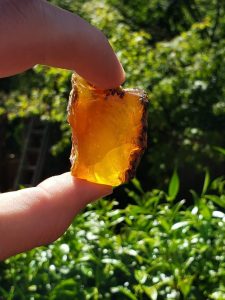
Photo Courtesy All Gems, No Wallet
Juniper Ridge Fire Opal
While all opals are found in areas with historically high volcanic activity, fire opals are more site-specific. For many gem enthusiasts, fire opals are often known as Mexican opals, because of their prevalence in this region. They were once prized by the Aztec and Mayan peoples, who called it “quetzalitzlipyollitli”, which translates as “the stone of the bird of paradise.”
In more recent times, fire opals were identified as early as the 1800s in Oregon, where volcanoes shaped the landscape. “Oregon fire opal really isn’t that well known,” Mattila said. “It’s blossomed into this really beautiful thing.”
For Mattila and Smith, their venture into mining started after Mattila discovered a life-changing 2.51-pound beauty from the Red October 2 Mine, owned by Jamie Lant who is known for his welcoming and encouraging attitude. It took Mattila five and a half hours to carefully extricate the 492-carat stone from the Earth.
“I got the surge of energy through me. It was an amazing feeling,” he said.
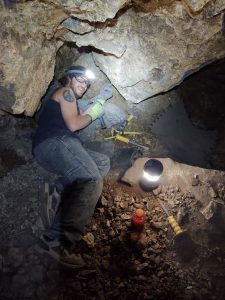
Photo Courtesy All Gems, No Wallet
Digging Fire Opal
Mattila said extremely large fire opals are a distinct possibility because of the way they’re formed. He explained that when you’re starting to mine you’re looking for telltale signs of the presence of the gems.
He said sometimes you’ll find a float opal that’s going to be on the surface. And in many instances there will be a layer of clay, and sometimes calcium-rich deposits, encompassing the area around the opal vein.
“You’ll find patches of that,” he said, and oftentimes if you do a little bit of digging, you’ll find a vein.“You could find a little chip, then pull out an almost three-pound opal,” he noted.
Miners often start their digs using a shovel and jackhammer to remove the bulk of the materials, but as they find layers of promising rock, the tools tone down to chisels and smaller hand tools. Once a seam or pocket is discovered, Mattila said, “It’s time to break out the surgical tools. You try your best not to crack it.”
Tapping into the veins, the fire opals often look like hardened amber sandwiched within the rock. Once located, it’s a matter of extricating the fire opals in as large a piece as possible. And while massive ones like Mattila’s prized opal are not specimens you find every day, it’s not uncommon to remove three-inch pieces of these beautiful gems.
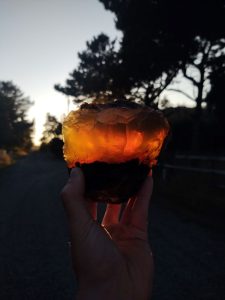
Photo Courtesy All Gems, No Wallet
From the Earth to Jewelry
With a Mohs scale of hardness rating of around 5.5, fire opals are softer than many stones used for faceting, yet they create stunning pieces when cut by the right hands. Mattila reached out to Mark Oros of Hashnu Stones and Gems, a brilliant and talented artist who is faceting Mattila’s large fire opal, as well as other pieces.
Along with being faceted by talented hands, fire opals are often found as a cabochon to enhance the dancing colors within the stone. They’re extremely popular when worn in protected mounts as necklaces or earrings, as well as eye-catching rings in any manner of sizes.
Mattila also noted that some fire opals contain dendrites, which are intrusions of iron, manganese oxide or pyrites. “It looks like moss exploded inside of it. It’s super beautiful.” He said that he’s even seen some fire opals that look like the sunset with lightning inside of them because of these unique formations.
“It’s a beauty that not a lot of people get to see. When I give someone an opal, they’re the second person in the world to touch it,” he said. “That’s significant.”
Fire opals are traditionally viewed as the stone of good fortune and success. This is true for those who experience the joy of digging them, creating beautiful jewelry with the often large pieces given by the earth, or for those wearing this fiery representation of the volcanoes from which they were born.
For more information, reach out to Austin Mattila 541-972-0953 or find him on Instagram at allgemsnowallet_agnw.
This story about Juniper Ridge fire opal previously appeared in Rock & Gem magazine. Click here to subscribe. Story by Amy Grisak.














